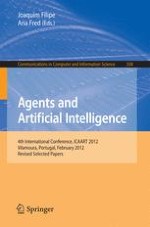2013 | Buch
Agents and Artificial Intelligence
4th International Conference, ICAART 2012, Vilamoura, Portugal, February 6-8, 2012. Revised Selected Papers
herausgegeben von: Joaquim Filipe, Ana Fred
Verlag: Springer Berlin Heidelberg
Buchreihe : Communications in Computer and Information Science
